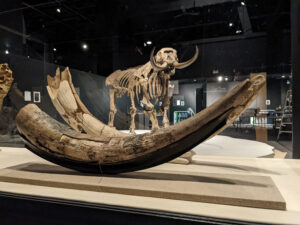“We’ve taken it up more than a few notches,” says Patrick about the lodge’s new culinary team. “We’re quite far in the wilderness, so we don’t do the lobsters and the lighthouses. You can do that in many other places.”
Instead, he says, Trout Point Lodge offers a four-course gourmet menu for dinner that changes every day.
This morning, however, I’m stepping back in time to sample a different kind of local fare — rappie pie, or râpure in French, an Acadian dish from southwest Nova Scotia.
“It takes five strong women and a bag of potatoes to make rappie pie,” chuckles Kara Pinkney-Crowell, as she starts my Acadian cooking class in the lodge’s main kitchen. Pinkney-Crowell is the lodge’s cook and a local guide whose Acadian-Mi’kmaq relatives fled Wedgeport, N.S., in the mid-1700s and hid in the woods where the community of Quinan is now, about 35 kilometres south of the lodge. This particular recipe from Pinkney-Crowell’s great grandmother combines finely ground potatoes, stock and chicken (left over from last night’s dinner) in a hearty, stick-to-your-ribs casserole. She cracks jokes between sharing cooking wisdom passed down through generations of her family. While we could layer the potatoes and chicken to make the dish look nice when it’s served, Pinkney-Crowell says, “if my great grandmother were here, she would do this,” and she mixes everything in one pot and pours the gloopy concoction into a casserole dish to bake.
When the rappie pie is brown on top and bubbling around the edges, Pinkney-Crowell serves me a generous wedge and suggests I drizzle maple syrup and hot sauce over top, like a local. I do and gobble down heaping forkfuls of soft potato and chicken. Pinkney-Crowell’s grandmère would be proud.
Later that day, the rain pauses long enough to trek over the cold, wet grass behind the lodge to a rustic, wood-fired hot tub on the banks of the Tusket. There are three trails running throughout the property and along the river. Fall’s chilly nights have ignited the trees in this part of the Tobeatic, and the river is blanketed in orange, red and yellow leaves.
I drop my robe and sink into hot water up to my chin. I can feel a few leaves swirling beneath my feet, and I hear the water bubbling over the Tusket’s rapids. I look back to the lodge. It’s just starting to get dark and guests are gathering in The Great Room. I can see Leblanc with his guitar, setting up his evening’s post by the big windows, ready to play.
This story was originally published in the 2020 May/June issue of Canadian Geographic.












